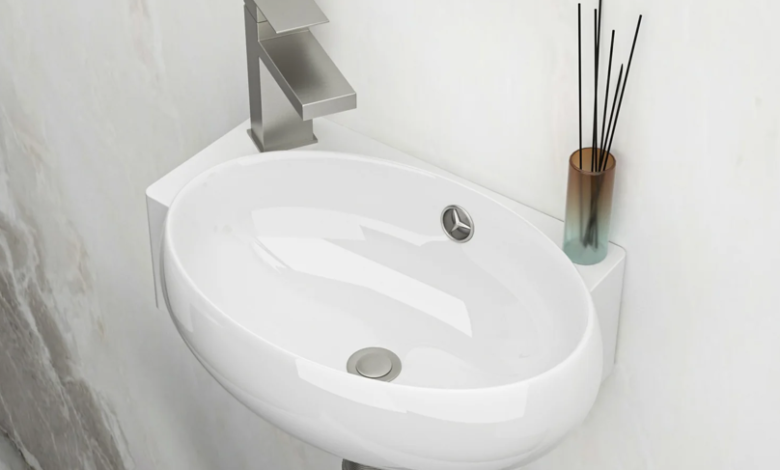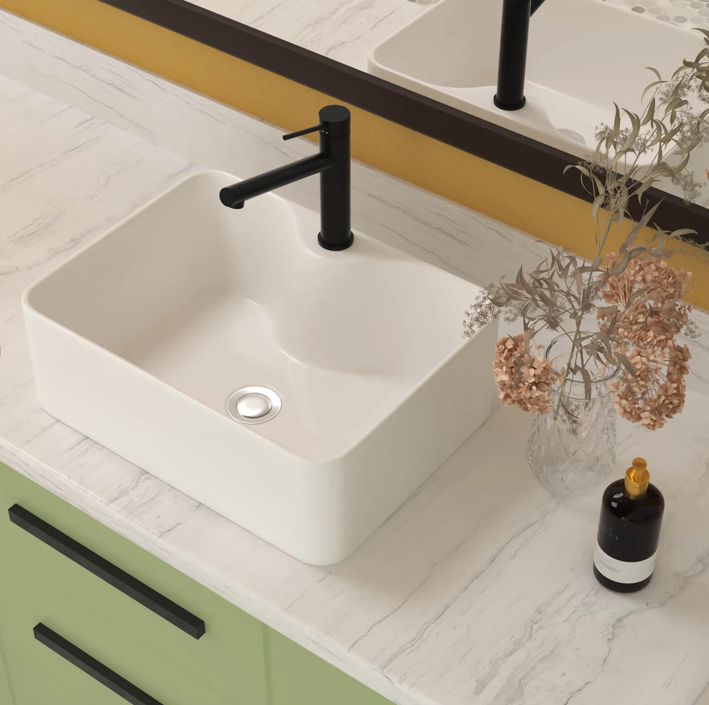Choosing the Right Material for Your Bathroom Vanity Sink

The sink is the most frequently used part of a bathroom vanity. Its material not only defines the vanity’s style and visual appeal but also directly impacts durability, ease of cleaning, and overall user experience. The most common sink materials on the market are ceramic, marble, and solid surface (a type of engineered stone). Each comes with its own advantages and drawbacks: ceramic is classic and durable, marble is luxurious and elegant, and solid surface is versatile and customizable. This guide breaks down the pros and cons of each material across three key aspects: aesthetics, practical performance, and maintenance cost—helping you pick the perfect sink for your bathroom.
1. Understanding the Core Material Types and Style Roles
Before comparing pros and cons, it’s important to understand the fundamental differences between these materials—their origins and design attributes—which determine the bathroom styles and use cases they best suit.
Ceramic Sinks:
Made from kaolin clay and fired at high temperatures, ceramic sinks are coated with a glaze. They are the most traditional sink material and fit well with minimalist, Scandinavian, and modern Chinese-inspired bathrooms. Key selling points: classic, versatile, and cost-effective.
Marble Sinks:
Available as a single-piece natural marble basin or a marble countertop with an under-mount sink (this guide focuses on single-piece marble basins). Ideal for light luxury, vintage, American, and modern Chinese-style bathrooms, marble offers premium aesthetics and natural veining.
Solid Surface Sinks:
Also called acrylic engineered stone sinks, these are made from resin and aluminum powders and can be seamlessly integrated with countertops. Perfect for minimalist, modern, or industrial bathrooms, solid surface sinks are highly customizable, offering sleek, seamless designs.
2. Comparing Pros and Cons
We’ll compare these three materials from five practical dimensions: aesthetics, durability, usability, maintenance, and cost.
Aesthetics and Style Compatibility
The look of your sink sets the tone for the entire vanity.
Ceramic:
- Pros: Smooth, glossy surface in white or off-white; simple, clean lines; easily fits various design styles; shapes include round, square, and oval.
- Cons: Limited texture and color choices; cannot achieve complex shapes or embedded details.
Marble:
- Pros: Unique natural veining for a high-end look; wide color range; can be carved with decorative edges or relief patterns.
- Cons: Veining is random, which may clash with minimalist designs; dark colors show water spots and fingerprints.
Solid Surface:
- Pros: Wide range of colors, including custom shades; seamless integration with countertop and walls; flexible shapes and built-in features; matte finish fits modern aesthetics.
- Cons: Texture is artificial; may feel less “natural” than marble; glossy finish options are limited.
Durability
Ceramic:
- Pros: Hard and scratch-resistant; heat resistant above 300°C; glazed surface resists yellowing.
- Cons: Brittle—can crack from heavy impact; edges may chip.
Marble:
- Pros: Hard, durable, heat resistant above 200°C; stable structure.
- Cons: Vulnerable to strong impact; porous surface can stain if not sealed properly.
Solid Surface:
- Pros: Flexible and impact-resistant; minor scratches can be sanded out; non-porous.
- Cons: Soft material; heat-sensitive (≤80°C); can scratch easily.

Practical Usability
Ceramic:
- Pros: Non-porous and easy to clean; standard depth prevents splashing.
- Cons: Shallow or ultra-thin designs may splash; harsh scrubbing can scratch glaze.
Marble:
- Pros: Can be customized with deep basins; broad countertop for toiletries.
- Cons: Porous surface can stain; requires special cleaners; cold to the touch.
Solid Surface:
- Pros: Seamless design prevents hidden grime; integrated splash guards; matte finish hides water spots.
- Cons: Can absorb oils; low-end products may swell over time; avoid harsh chemicals.
Maintenance Costs
Ceramic:
- Pros: Very low maintenance; easy cleaning; long lifespan.
- Cons: Cracks require full replacement.
Marble:
- Pros: Minor scratches and stains can be polished; maintains elegance when sealed.
- Cons: Regular sealing required every 3–6 months; high repair and replacement costs; heavy and difficult to handle.
Solid Surface:
- Pros: Minor scratches can be sanded and polished; easier maintenance than marble.
- Cons: Heat-sensitive; low-quality materials may yellow; lifespan 3–10 years depending on quality.
Cost
Ceramic:
- Purchase: Budget-friendly to mid-range ($15–$50 for standard models, premium $50–$150).
- Long-term: Minimal, ~ $3–$8/year.
Marble:
- Purchase: High-end, $300–$800+, depending on quality.
- Long-term: Higher maintenance costs, ~ $15–$30/year.
Solid Surface:
- Purchase: Mid-range, $50–$400+ depending on custom options.
- Long-term: Moderate, ~ $10–$25/year.
See also: Top Signs Your Home Needs Mold Remediation
3. Buying Guide: Match Material to Style, Needs, and Budget
Choose Ceramic if:
- Your bathroom is minimalist, Scandinavian, or modern Chinese style.
- You want durable, easy-to-clean sinks suitable for children or seniors.
- Budget-conscious (~$50 or less).
- Tip: Pick thick glazed, one-piece sinks for durability.
Choose Marble if:
- Your bathroom is luxury, vintage, or modern Chinese style.
- You want a unique, high-end look and can commit to regular maintenance.
- Budget is $300+ and appearance is a priority.
- Tip: Pick sealed, light-colored marble to reduce staining.
Choose Solid Surface if:
- Your bathroom is modern, minimalist, or industrial.
- You want custom shapes, seamless integration, and easy cleaning.
- Budget is mid-range (~$100–$300).
- Tip: Choose high-density resin and request heat-resistance testing.
Conclusion
Ceramic wins for durability and ease of use, marble stands out with premium aesthetics, and solid surface impresses with flexible, seamless designs. Choosing the right sink depends on your bathroom’s style, daily routines, and budget. After all, a well-chosen sink should make everyday washing simple and enjoyable.
For a range of high-quality options in any of these materials, explore the Giving Tree Home vanity collection to find the perfect fit for your bathroom.

